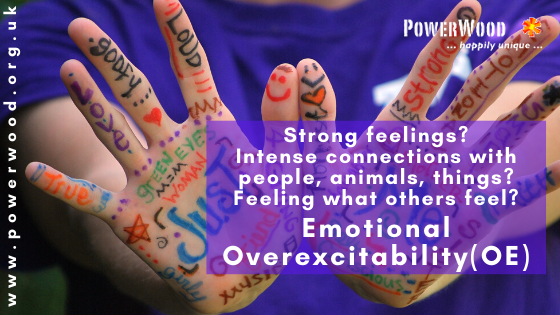
Exploring OverExcitability – E-Book FREE when a member, read about:
- How having OE might affect yourself and/or your child.
- Where this behaviour stems from.
- How it can be misdiagnosed.
- What the strengths are of having Overexcitability.
Emotional OE
 People with an emotional OE experience extremely complex emotions, both positive and negative. Feelings can be intense and they have strong emotional connections with other people, places and objects. Being compassionate, empathetic and sensitive to the needs of others they often feel what others feel, find it hard to make a distinction between their own and others feelings and have a tendency to put these feelings above their own needs. They may have deep concerns about their behaviour in relationships and the well-being of people important to them. They can also be very self-critical and experience feelings of inadequacy and inferiority.
People with an emotional OE experience extremely complex emotions, both positive and negative. Feelings can be intense and they have strong emotional connections with other people, places and objects. Being compassionate, empathetic and sensitive to the needs of others they often feel what others feel, find it hard to make a distinction between their own and others feelings and have a tendency to put these feelings above their own needs. They may have deep concerns about their behaviour in relationships and the well-being of people important to them. They can also be very self-critical and experience feelings of inadequacy and inferiority.
The emotionally OE have a deep need for connection and intensity with others, often leading to conflict over the depth of relationships. Children and teenagers and even young adults can feel very lonely as it is often hard to find such connections.
Being idealistic, they want to help others or animals and can be sad and deeply disappointed when they realise that not everybody feels so passionately. Being overwhelmed by those intense emotions and not knowing how to be in charge of yourself and your extreme sensitivity can be daunting.
One mother described how, as she was driving hurriedly, her daughter cried, “Stop! Slow down!” When the mother asked why, the daughter replied, “We’re killing bugs on the windshield, and I’ve already seen too much death for my age!” (Webb et al, 2005).
Emotionally tense children can act out with extreme anger tantrums, become greatly upset when they lose a game or mourn for months when a new friend stops wanting to play. They are often seen to be overreacting and think that an emotion will last forever. They can have difficulty with change and adjusting to new environments, be extremely shy and timid and are prone to being bullied. To protect themselves, these children frequently learn to hide their sensitivity. They may experience deep feelings of guilt, depression and suicidal thoughts from a very young age.
“My mother threw out my favourite red sweater, I tried very hard but I didn’t manage to get it back and I felt so deeply bereft as if I was mourning, which is silly really over a sweater, but I did feel it like that.” Melissa 15 years
Somatic expressions can also be extreme: tense stomach, sinking heart and blushing, which might add to the tension. They often remember precisely how they and others felt in certain situations.
Dabrowski saw emotional OE as the most important. People with this excitability will have the drive to make the world a better place, not just for themselves but for everyone. Developing deep emotional bonds with family, friends, animals and charitable goals, they have a rich interpersonal life that is often used professionally.
Read more about the other areas of intensity: Psychomotor, Sensual, Intellectual, Imaginational and Emotional.
PowerWood’s Community
Find understanding, tools and strategies that work in an understanding, respectful and compassionate Community.
PowerWood can be your and your families advocate and your second family.
Explore how joining our PowerWood community by becoming a member will benefit you and your family and what types of memberships are available.
Join our Community
Available to Members*
*Booking a one-off Free Introductory Talk of 45-60 minutes by Skype or FaceTime with Senior Consultant Simone de Hoogh is one of the benefits of being either a FreeBee PowerWood Community Member or a Friend PowerWood Community Member.
Book a FREE Introductory Talk with a Professional*
You can read more about PowerWood’s Consultancy Sessions, the Benefits of a Free Introductory Talk and PowerWood’s Consultancy Services Tiered Fee Structure.
*Overexcitability Test
OE (Overexcitability) is an element of a Developmental Theory –Theory of Positive Disintegration by Dabrowski- that is one of the underpinning theories of MERT (Multi-level Emotion Regulation Theory) developed by Simone de Hoogh. Overexcitability explains and allows us to look at ‘extreme’ behaviour as a valuable asset in our or our children’s life.
Find out if you or your child has OE (OverExcitability) as well
*Boundary Test
A HUGE thank YOU to the son and daughter of Ernest Hartmann’s who gave PowerWood permission to use and put the full academically approved questionnaire about the Boundary in the Mind on PowerWood’s website.
Find out how the Boundary in the Mind affects you or your child
Further Reading
UK
Lucinda Leo’s blog: 15 Things Your Child With Emotional Overexcitability Might Say
USA
SENG: The gift of emotional overexcitabilities
Living With Intensity: Understanding the Sensitivity, Excitability and Emotional Development of Gifted Children, Adolescents and Adults (Book edited by Daniels and Piechowski)
Misdiagnosis and Dual Diagnosis of Gifted Children and Adults (Book by a.o. James T Webb)
Jade Ann Rivera – How to identify and cope with overexcitabilities, part 1 of 5: Emotional overexcitability
